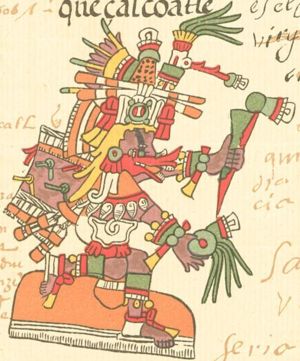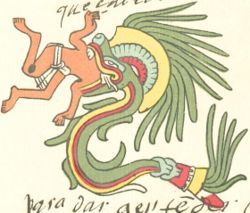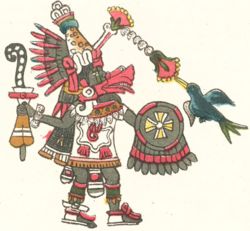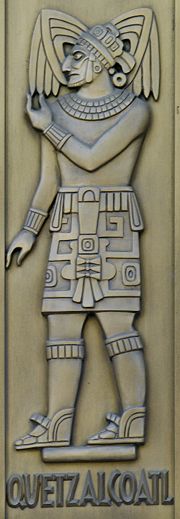Quetzalcoatl
2008/9 Schools Wikipedia Selection. Related subjects: Divinities
Quetzalcoatl ( Classical Nahuatl: Quetzalcōhuātl pronounced [ke.ʦal.ˈkoː.waːtɬ]) is an Aztec sky and creator god. The name is a combination of quetzalli, a brightly colored Mesoamerican bird, and coatl, meaning serpent. The name was also taken on by various ancient leaders. Due to their cyclical view of time and the tendency of leaders to revise histories to support their rule, many events and attributes attributed to Quetzalcoatl are exceedingly difficult to separate from the political leaders that took this name on themselves. Quetzalcoatl is often referred to as The Feathered Serpent and was connected to the planet Venus. He was also the patron god of the Aztec priesthood, of learning and knowledge. Today Quetzalcoatl is arguably the best known Aztec deity, and is often thought to have been the principal Aztec god. However, Quetzalcoatl was one of several important gods in the Aztec pantheon along with the gods Tlaloc, Tezcatlipoca and Huitzilopochtli.
Several other Mesoamerican cultures are known to have worshipped a feathered serpent god: At Teotihuacan the several monumental structures are adorned with images of a feathered serpent (Notably the so-called "Citadel and Temple of Quetzalcoatl"). Such imagery is also prominent at such sites as Chichén Itza and Tula. This has led scholars to conclude that the deity called Quetzalcoatl in the Nahuatl language was among the most important deities of Mesoamerica.
The god Quetzalcoatl was sometimes conflated with Topiltzin Ce Acatl Quetzalcoatl, a semi-legendary 10th century Toltec ruler.
Antecedents and origins
The Feathered Serpent deity was important in art and religion in most of Mesoamerica for close to 2,000 years, from the Pre-Classic era until the Spanish conquest. Civilizations worshiping the Feathered Serpent included the Mixtec, Toltec, Aztec, who adopted it from the people of Teotihuacan, and the Maya.
The cult of the serpent in Mesoamerica is very old; there are representations of snakes with bird-like characteristics as old as the Olmec preclassic (1150-500 BC). The snake represents the earth and vegetation, but it was in Teotihuacan (around 150 BC) where the snake got the precious feathers of the quetzal, as seen in the Murals of the city. The most elaborate representations come from the old Quetzalcoatl Temple around 200 BC, which shows a rattlesnake with the long green feathers of the quetzal.
Teotihuacan was dedicated to Tlaloc, the water god, at the same time Quetzalcoatl, as a snake, was a representation of the fertility of the earth, and it was subordinate to Tlaloc. As the cult evolved, it became independent.
In time Quetzalcoatl was mixed with other gods and acquired their attributes. Quetzalcoatl is often associated with Ehecatl, the wind god, and represents the forces of nature, and is also associated with the morning star (Venus). Quetzalcoatl became a representation of the rain, the celestial water and their associated winds, while Tlaloc would be the god of earthly water, the water in lakes, caverns and rivers, and also of vegetation. Eventually Quetzalcoatl was transformed into one of the gods of the creation ( Ipalnemohuani).
The Teotihuacan influence took the god to the Mayas, who adopted him as Kukulkán. The Maya regarded him as a being who would transport the gods.
In Xochicalco (700-900 CE), the political class began to claim that they ruled in the name of Quetzalcoatl, and representations of the god became more human. They influenced the Toltec, and the Toltec rulers began to use the name of Quetzalcoatl. The Toltec represented Quetzalcoatl as man, with god-like attributes, and these attributes were also associated with their rulers.
The most famous of those rulers was Topiltzin Ce Acatl Quetzalcoatl. Ce Acatl means "one reed" and is the calendaric name of the ruler (923 - 947), whose legends became almost inseparable from accounts of the god. The Toltecs would associate Quetzalcoatl with their own god, Tezcatlipoca, and make them equal and enemies.
The Nahuas would take the legends of Quetzalcoatl and mix them with their own. Quetzalcoatl would be considered the originator of the arts, poetry and all knowledge. The figure of Ce Acatl would become inseparable from the image of the god.
Speculative literature has also associated Quetzalcoatl with Votan, a culture hero mentioned in a 1702 account of Tzeltal beliefs and practices in Chiapas by Bishop Nuñez de la Vega.
Religion and ritual
The worship of Quetzalcoatl sometimes included animal sacrifices, and in most traditions Quetzalcoatl was said to oppose human sacrifice.
Mesoamerican priests and kings would sometimes take the name of a deity they were associated with, so Quetzalcoatl and Kukulcan are also the names of historical persons.
One noted Post-Classic Toltec ruler was named Quetzalcoatl; he may be the same individual as the Kukulcan who invaded Yucatán at about the same time. The Mixtec also recorded a ruler named for the Feathered Serpent. In the 10th century a ruler closely associated with Quetzalcoatl ruled the Toltecs; his name was Topiltzin Ce Acatl Quetzalcoatl. This ruler was said to be the son of either the great Chichimeca warrior, Mixcoatl and the Culhuacano woman Chimalman, or of their descent.
It is believed that the Toltecs had a dualistic belief system. Quetzalcoatl's opposite was Tezcatlipoca, who, in one legend, sent Quetzalcoatl into exile. Alternatively, he left willingly on a raft of snakes, promising to return.
The Aztecs turned him into a symbol of dying and resurrection and a patron of priests. When the Aztecs adopted the culture of the Toltecs, they made twin gods of Tezcatlipoca and Quetzalcoatl, opposite and equal; Quetzalcoatl was also called White Tezcatlipoca, to contrast him to the black Tezcatlipoca. Together, they created the world; Tezcatlipoca lost his foot in that process.
Along with other gods, such as Tezcatlipoca and Tlaloc, Quetzalcoatl was called "Ipalnemohuani", a title reserved for the gods directly involved in the creation, which means "by whom we live". Because the name Ipalnemohuani is singular, this led to speculations that the Aztec were becoming monotheistic and all the main gods were only one. While this interpretation cannot be ruled out, it is probably an oversimplification of the Aztec religion.
Attributes
The exact significance and attributes of Quetzalcoatl varied somewhat between civilizations and through history. Quetzalcoatl was often considered the god of the morning star, and his twin brother Xolotl was the evening star (Venus). As the morning star he was known by the title Tlahuizcalpantecuhtli, meaning "lord of the star of the dawn." He was known as the inventor of books and the calendar, the giver of maize (corn) to mankind, and sometimes as a symbol of death and resurrection. Quetzalcoatl was also the patron of the priests and the title of the Aztec high priest.
Most Mesoamerican beliefs included cycles of suns. Usually, our current time was considered the fifth sun, the previous four having been destroyed by flood, fire and the like. Quetzalcoatl allegedly went to Mictlan, the underworld, and created fifth-world mankind from the bones of the previous races (with the help of Chihuacoatl), using his own blood, from a wound in his penis, to imbue the bones with new life.
His birth, along with his twin Xolotl, was unusual; it was a virgin birth, to the goddess Coatlicue. Alternatively, he was a son of Xochiquetzal and Mixcoatl.
One Aztec story claims that Quetzalcoatl was seduced by Tezcatlipoca into becoming drunk and sleeping with a celibate priestess, and then burned himself to death out of remorse. His heart became the morning star (see Tlahuizcalpantecuhtli).
Moctezuma controversy
It has been widely believed that the Aztec Emperor Moctezuma II initially believed the landing of Hernán Cortés in 1519 to be Quetzalcoatl's return. This has been questioned by many ethnohistorians (e.g. Matthew Restall 2001) who argue that the Quetzalcoatl-Cortés connection is asserted in no documents created independently of post-Conquest Spanish influence, and that there is little proof of a pre-Hispanic belief in Quetzalcoatl's return. Most documents expounding this theory are of entirely Spanish origin, such as Cortés's letters to Charles V of Spain, in which Cortés goes to great pains to present the naïve gullibility of the Mexicans in general as a great aid in his conquest of Mexico.
Much of the idea of Cortés being seen as a deity can be traced back to the Florentine Codex written down some 50 years after the conquest. In the codex's description of the first meeting between Moctezuma and Cortés, the Aztec ruler is described as giving a prepared speech in classical oratorial Nahuatl, a speech which, as described verbatim in the codex (written by Sahagún's, Tlatelolcan informants who were probably not eyewitnesses of the meeting), included such prostrate declarations of divine or near-divine admiration as,
"You have graciously come on earth, you have graciously approached your water, your high place of Mexico, you have come down to your mat, your throne, which I have briefly kept for you, I who used to keep it for you,"
and,
"You have graciously arrived, you have known pain, you have known weariness, now come on earth, take your rest, enter into your palace, rest your limbs; may our lords come on earth."
Subtleties in, and an imperfect scholarly understanding of, high Nahuatl rhetorical style make the exact intent of these comments tricky to ascertain, but Restall argues that Moctezuma politely offering his throne to Cortés (if indeed he did ever give the speech as reported) may well have been meant as the exact opposite of what it was taken to mean: politeness in Aztec culture was a way to assert dominance and show superiority. This speech, which has been widely referred to, has been a factor in the widespread belief that Moctezuma was addressing Cortés as the returning god Quetzalcoatl.
Other parties have also propagated the idea that the Native Americans believed the conquistadors to be gods: most notably the historians of the Franciscan order such as Fray Gerónimo de Mendieta. Some Franciscans at this time held millennarian beliefs (Phelan 1956) and the natives taking the Spanish conquerors for gods was an idea that went well with this theology. Bernardino de Sahagún, who compiled the Florentine Codex, was also a Franciscan.
Some scholars still hold the view that the fall of the Aztec empire can in part be attributed to Moctezuma's belief in Cortés as the returning Quetzalcoatl, but most modern scholars see the "Quetzalcoatl/Cortés myth" as one of many myths about the Spanish conquest which have risen in the early post-conquest period.
However, it is interesting to note the resemblance of the Quetzacoatl legend with that of the myth of the Pahana held by the Hopis of northern Arizona. Scholars have described many similarities between the myths of the Aztecs and those of the American Southwest, and posit a common root. The Hopi describe the Pahana as the "Lost White Brother," and they expected his eventual return from the east during which he would destroy the wicked and begin a new era of peace and prosperity. Hopi tradition maintains that they at first mistook the Spanish conquistadors as the Pahana when they arrived on the Hopi mesas in the 16th century.
Alternative interpretations
Modern esoteric groups, called " Mexicanistas", have mixed the cult of Quetzalcoatl with modern esoteric practices.
Creationists, in a effort to present ancient myths as literal truth, have suggested that the Quetzalcoatl is a definition or description of a pterodactyl. They believe their idea to have merit due to supposed (unconfirmed) sightings of pterodactyls throughout the Americas, from early European colonization to modern times.
Some believers in The Book of Mormon assert some references to Quetzalcoatl are a corruption of the story of Jesus Christ, of whom The Book of Mormon states visited the Mesoamerican natives after his resurrection.





